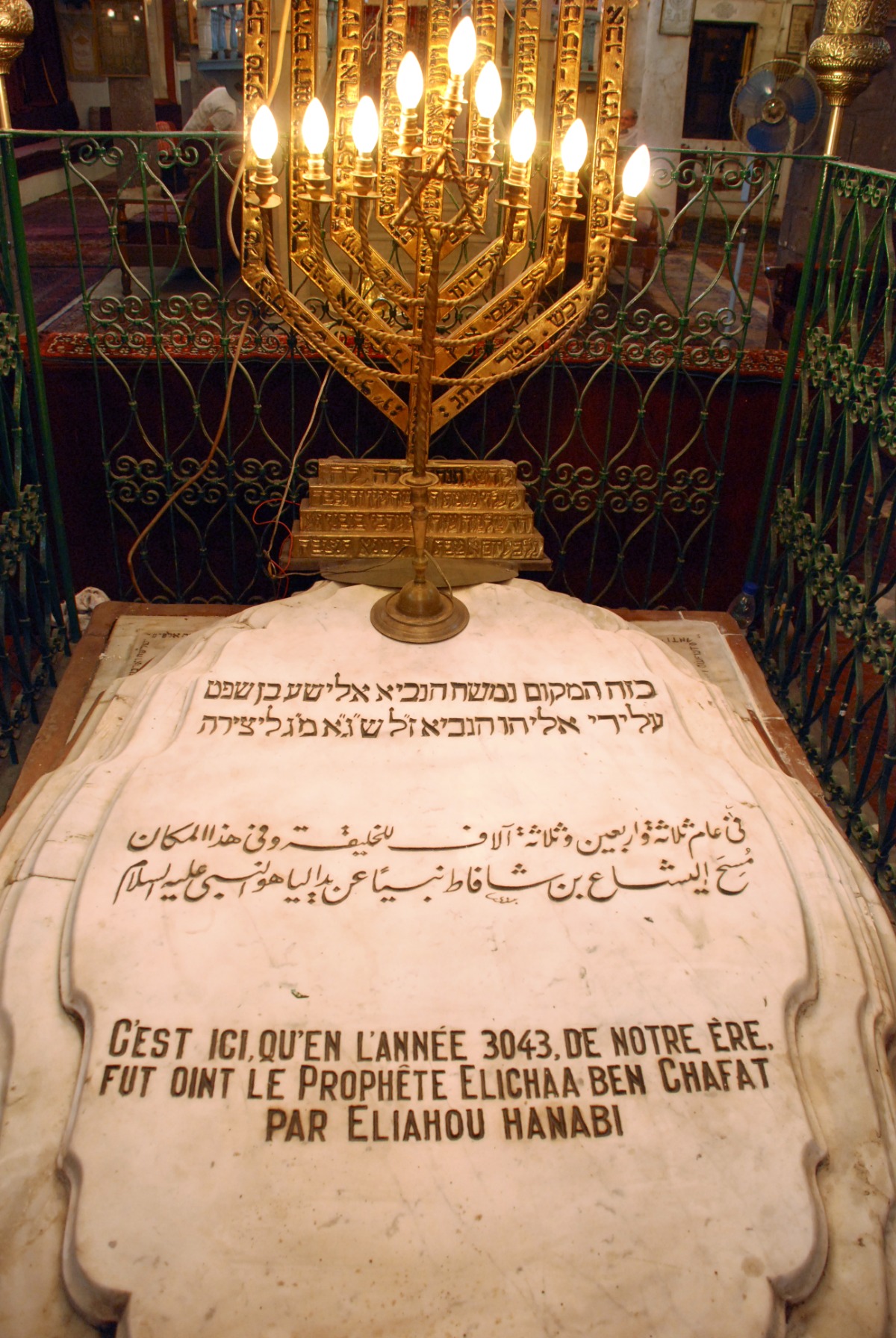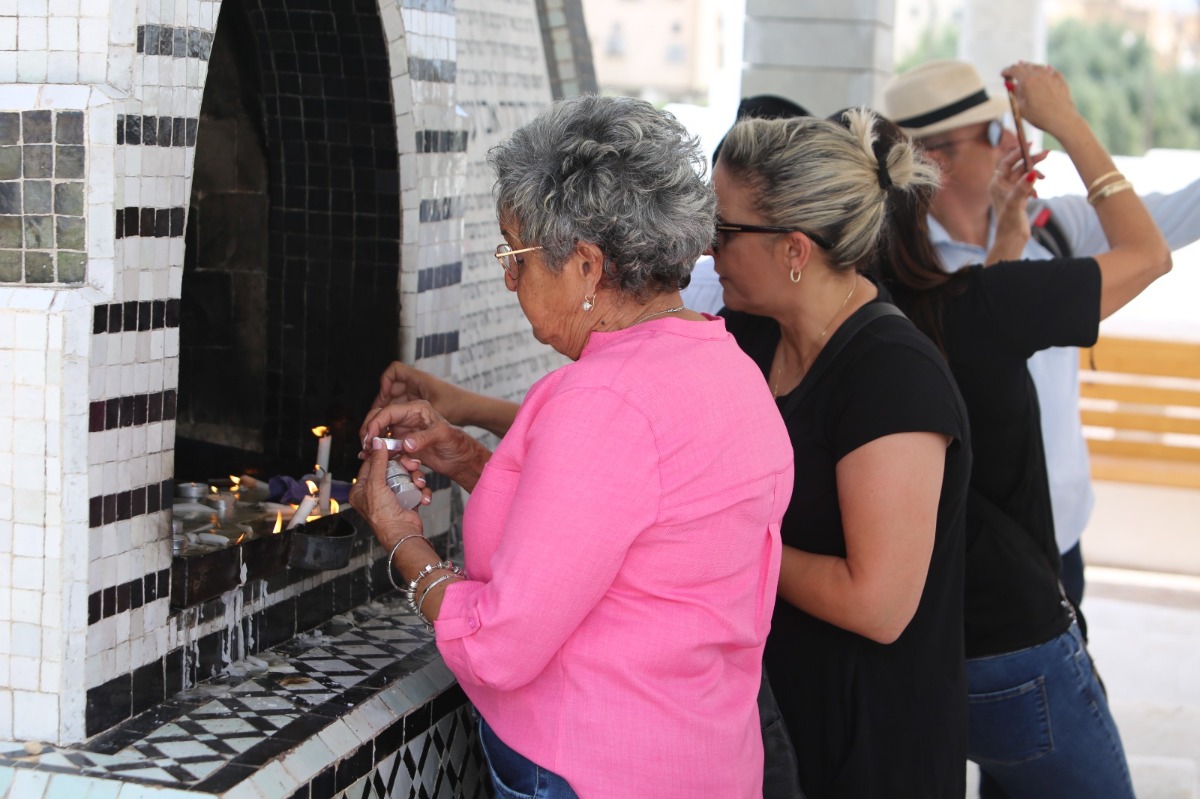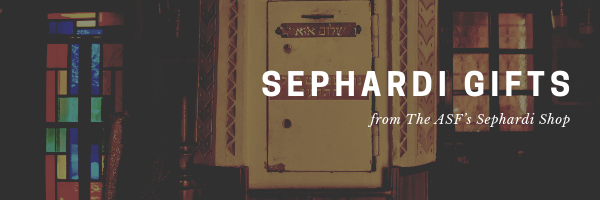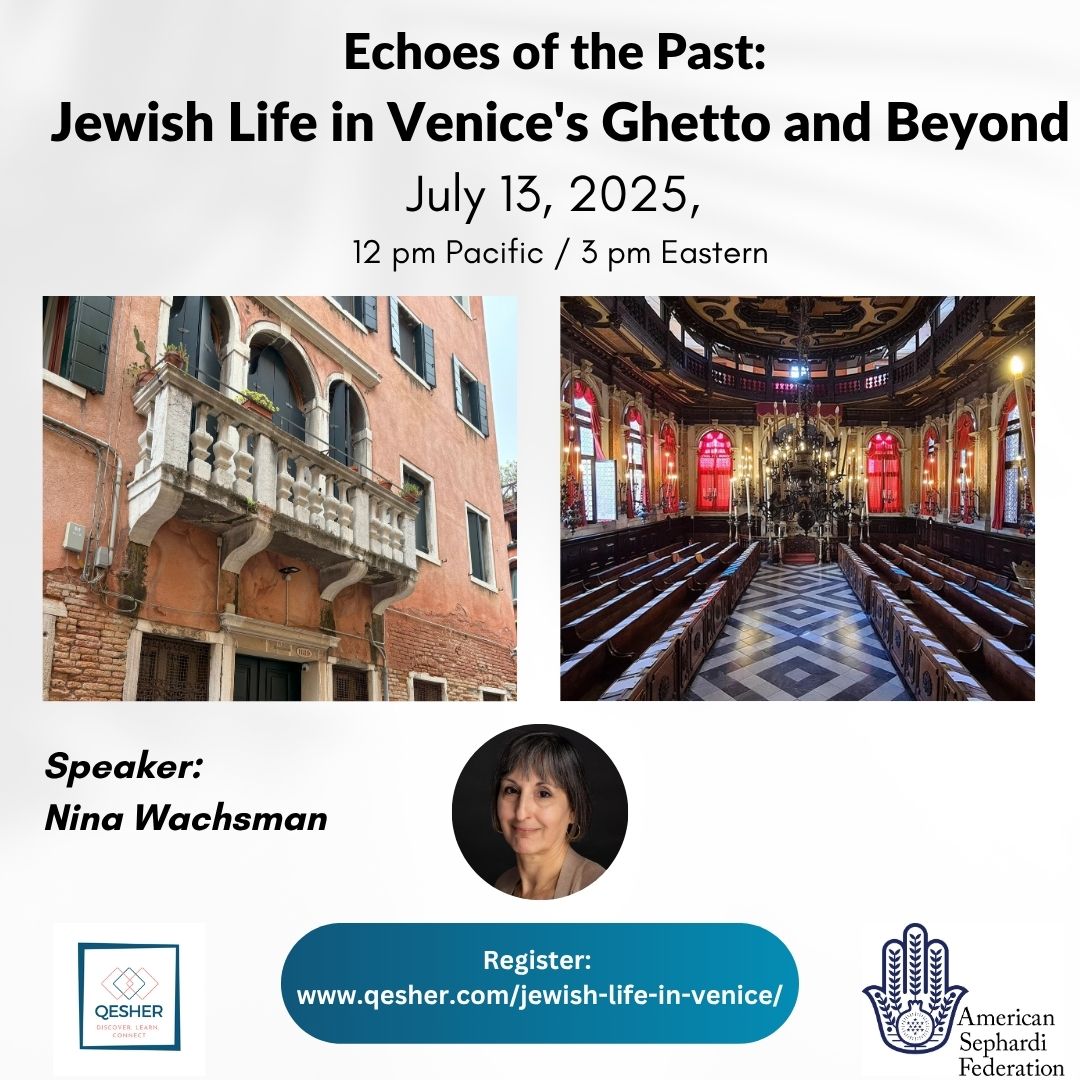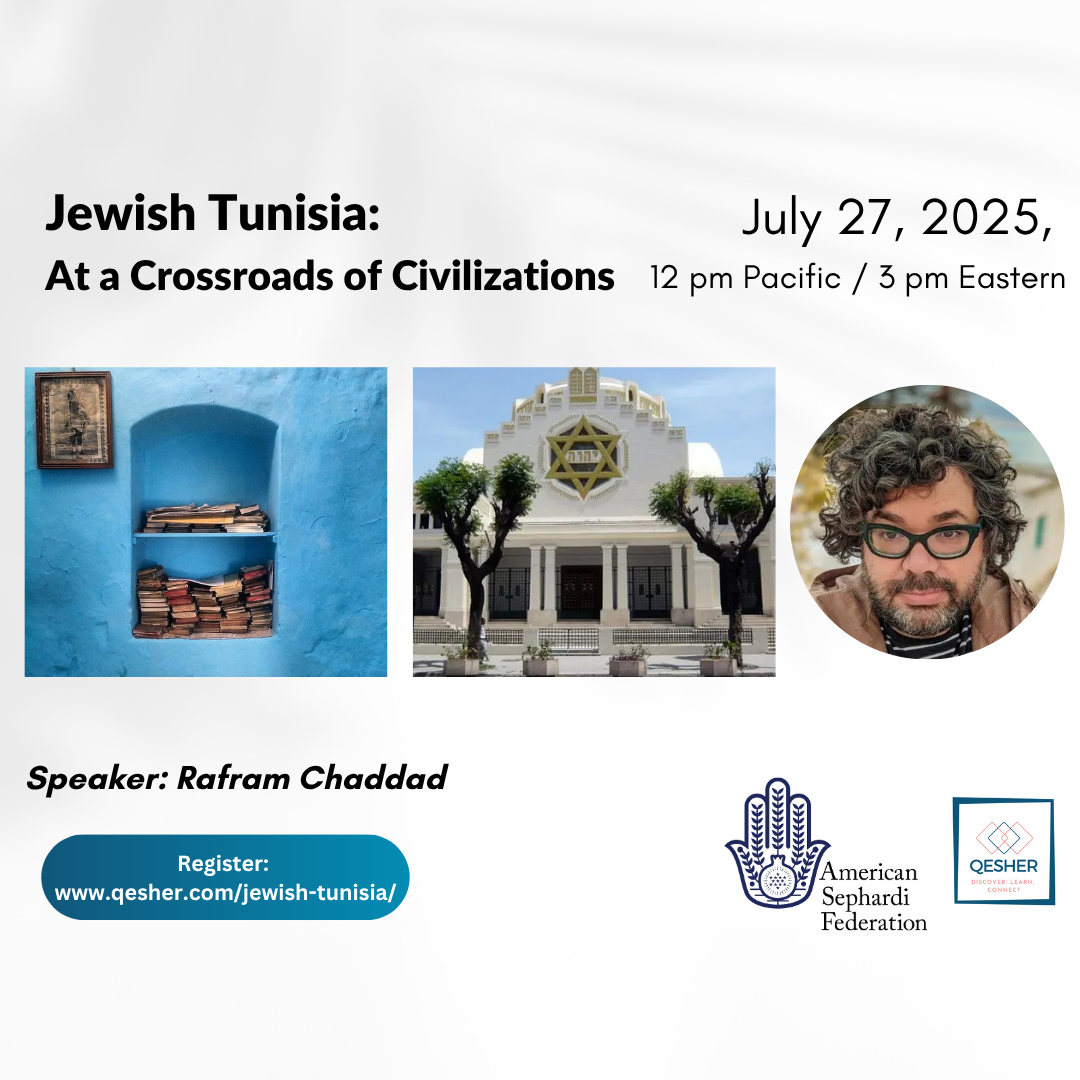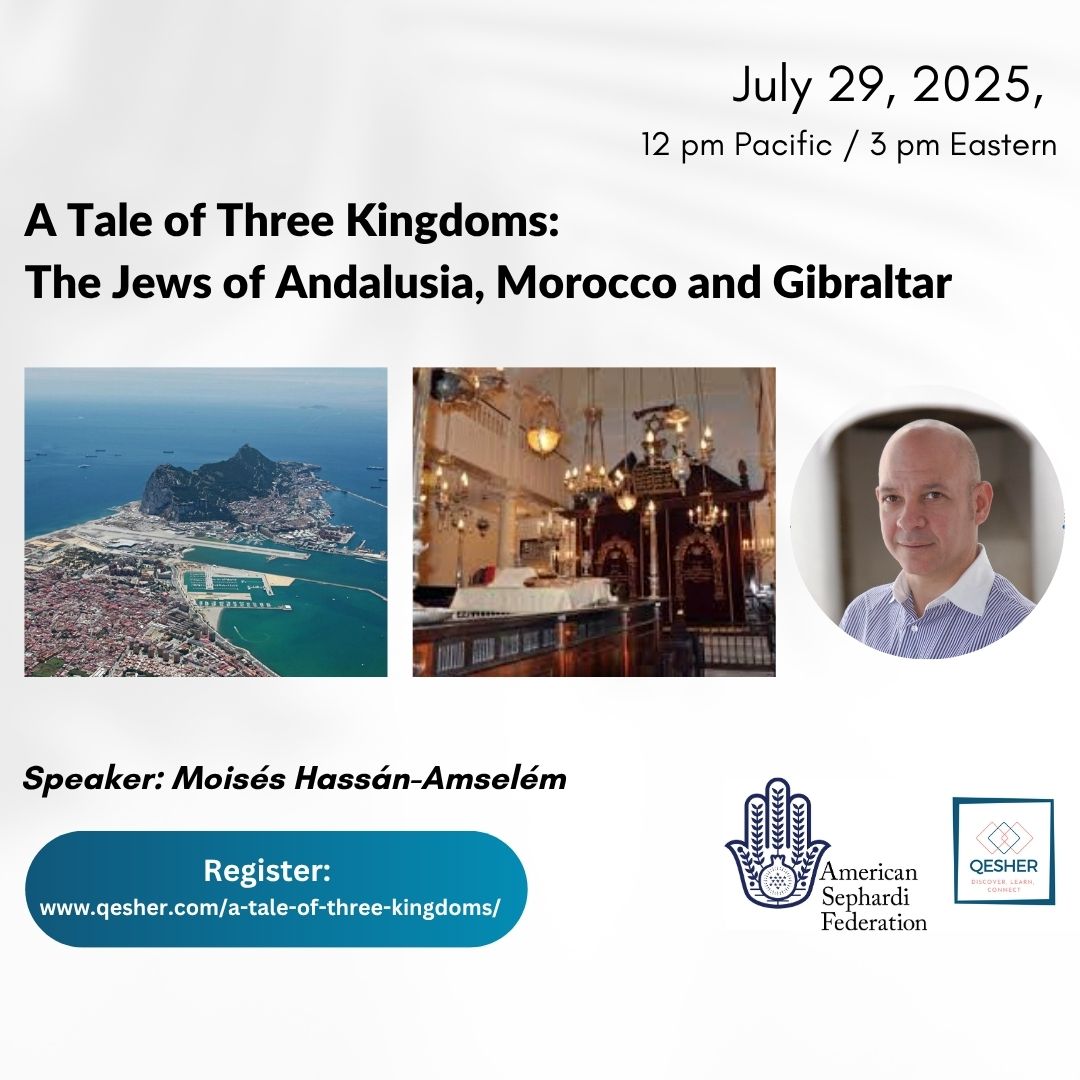In Memory of two Yemenite-Israeli intellectual and cultural exemplars, Aharon Amram, A”H and Mordechai Yitshari, A”H. Amram was a renowned singer, researcher, and preserver of Yemenite Jewish music. Yitshari, a poet and pioneer, edited the Diwan of General Yemeni Poetry and helped create Rosh HaAyin’s coat of Arms.
Click here to dedicate a future issue in honor or memory of a loved one
Subscribe ◊ Upcoming Events ◊ ASF Sephardi Shop ◊ Donate ◊ Sephardi Ideas Monthly ◊ ASF IJE ◊ ASF Sephardi House ◊ Archive
The Sephardi World Weekly is made possible by Daniel Yifrach, Rachel Sally, Professor Rifka Cook, Maria Gabriela Borrego Medina, Rachel Amar, Deborah Arellano, & ASF VP Gwen Zuares!
Don’t miss the latest Sephardi Ideas Monthly: “Two Jewish Songs, Ancient and Israeli”
“With only six Jews left in Syria, émigrés now have a chance to return”
By Mohamad El Chamaa, The Washington Post
A menorah atop the former plaque that attested (in Hebrew, Arabic, and French) to this being the spot where Elijah the Prophet anointed Elisha as his successor, Eliyahu HaNabi Synagogue, Jobar, Damascus, Syria, May 2009. Contrary to a false report, the Synagogue was destroyed in 2014.
(Photo courtesy of Chrystie Sherman/Diarna Geo-Museum of North African & Middle Eastern Jewish Life)
With the fall of the Assad regime, Syrian Jews hope to visit the land that was once home to a spiritually and economically vibrant Jewish community. Some have already made the journey.
In February, Henry Hamra and his father traveled to Damascus and met with the new rulers. Henry was 15 when he left Syria. “It was very emotional to come back after 33 years.” On his first night, Hamra slipped away from his government-assigned escorts: “‘I took a taxi and I went right next to my house, right next to the synagogue. I was just walking in the dark.’”
The Jewish presence in Syria dates back to Biblical times, but starting with the Damascus Blood Libel of 1840 and accelerating after 1947 mob attacks communal life became precarious. ASF Executive Director Jason Guberman notes that the government even took aggressive measures against the Jewish community, with “Jewish leaders and entire neighborhoods… surveilled, correspondence… monitored and censored, restrictions… placed on employment and the teaching of modern Hebrew… banned.” During the 1980s, Syrian Jewish émigrés in the United States, especially in Brooklyn, supported new arrivals fleeing Assad’s brutal regime.
Despite hopes for Syria’s future, harsh realities persist.
~~~~~~~
FEATURE: Celebrating American Excellence on the Bandstand
Albert Murray Montage
(Image courtesy of The Dispatch)
The Dispatch is a throwback to old-school journalism, committed to clarifying the truth and telling stories that reflect the depths of American culture. In keeping with this mission, The Dispatch recently published an eight-minute video essay dedicated to the Omni-American Future Project, co-founded by the ASF’s Director of Publications, Dr. Aryeh Tepper, and Greg Thomas.
Jazz might be the ultimate American art form—a living testament to the nation’s creative spirit and diversity. Albert Murray (1916–2013), an influential American writer and cultural critic, argued that jazz is the blueprint for genuine “antiracism” in the United States. Murray also coined the term “Omni-American” as a sign for America’s pluralistic culture that, by definition, invites rooted cosmopolitans from all cultural backgrounds to share their riches at the peaks of human excellence. In this respect, the Omni-American vision is an American parallel to the Classic Sephardi Jewish vision (see, for instance, Hegyonei Uziel, Book 2, pp. 127, 140, 154)
This humane vision inspires Tepper and Thomas, whose Omni-American Future Project promotes a robust, pluralistic center in American society by harnessing the unifying power of music and culture. In doing so, they honor Albert Murray’s legacy, combatting illiberal extremes and fostering a more inclusive, dynamic national identity.
~~~~~~~
“In Fez, Morocco’s Jewish community clings to hope amid uncertainty”
By Ayelet Mamo Shay, YNet
Pilgrims light memorial candles in Fez, Morocco, 2003
(Photo courtesy of Mimouna Association)
The Moroccan city of Fez is a historic symbol of monotheistic coexistence where Muslims and Jews lived side by side for centuries. This tradition of coexistence was highlighted during the recent annual hilula (pilgrimage) to the Fez gravesite of Rabbi Yehuda Ibn Atar, which brought together about 150 Jews—mostly from France but also Israel—for a communal meal, even amid regional tensions. The event showcased an enduring sense of mutual respect and security in Moroccan society. In the words of journalist Ayelet Mamo Shay, who documented the hilula, “‘I was moved to see everyone feeling secure, even in the heart of a Muslim country. The warmth of the people slowly eased my worries.’”
While Morocco’s Jewish community has deep roots, it has also faced challenges. The prior government was led by Islamists, the Party of Justice and Developed (PJD), and after October 7th hundreds of thousands took to the streets to protest in support of Hamas. Government statements were not reassuring, although have seen returned to normal and relations overall never waivered due to the steadfast support of the monarchy.
Fez’s Jewish community is one of the oldest in North Africa, flourishing under Islamic rule and enriched by Sephardic Jews expelled from Spain and Portugal. This produced a vibrant community, home to renowned scholars like Maimonides (Rambam) and Rabbi Isaac Alfasi (the Rif).
Despite mass emigration, Fez’s small Jewish community has preserved its traditions and sites. Though now small and aging, a legacy of dignity and mutual respect endures, offering a model of coexistence in a region often marked by division, and even as Islamist influence remains a notable feature of Morocco’s national life.
~~~~~~~
Please support the ASF with a generous, tax-deductible contribution so we can continue to cultivate and advocate, preserve and promote, as well as educate and empower!
~~~~~~~
The Aristocrat: The Life and Legacy of Hillel Menashe Sutton
by Abraham Sutton
With this memoir, a tribute to the memory of his father, Abraham (Al) Sutton presents a brief synopsis of the history of the Jewish community of Aleppo, Syria, up to and through its diasporas to Tel Aviv, Jerusalem, New York, New Orleans, and Deal, New Jersey. All this in a thin volume generously laced with photographs. Al Sutton lost his father when he was only eleven years old. He thought he knew him; but one day he discovered that there had been a eulogy by a renowned kabbalist. He eventually found the text; what he discovered in the process provides the foundation of The Aristocrat. The book is interesting, fast moving, and sparkles with little glimpses of everyday life in a land (Aleppo) that was continuously inhabited by Jewish people from Biblical times until the late 20th century. There are also scenes of Israel during the War of Independence, and Syrian Jewish life in the United States. Author’s notes, bibliography.
Remnant of Israel a Portrait of America's First Jewish Congregation
by Hakkham Rabbi Dr. Marc D. Angel
Special Edition for the American Sephardi Federation
Published to mark Shearith Israel's 350th anniversary, Remnant of Israel a Portrait of America's First Jewish Congregation tells their individual stories as well as the history of the Congregation, explaining its origins, its rituals, and its traditions. It is profusely illustrated with portraits, historical documents and ritual objects. This book tells a fascinating story, one that will appeal to anyone interested in the history and culture of the Jewish People, of New York City, and of the United States.
~~~~~~~
Upcoming Events or Opportunities
Our friends at Qesher in partnership with the American Sephardi Federation present:
Echoes of the Past: Jewish Life in Venice's Ghetto and Beyond
“This talk will describe Jewish life within and outside the Venetian Ghetto and the famous men and women from its Golden Age.
We will discuss the legacy of Golden Age Venice reflected in both Jewish and non-Jewish culture, in music, poetry, scholarship, art, and food. You will come away with a better appreciation of the unique relationship between the city of Venice and its Jews.”
Sunday, 13 July at 3:00PM EST
Sign-up Now!
Tickets: $9-$18
About the speaker:
“Nina Wachsman is a descendant of a chief rabbi of Venice and her family's Sabbath candlesticks were supposedly sourced from the Ghetto (rumored to have been pawned there by a nobleman). The family connection and her study of art at Parsons School of Design spurs her to visit Venice every two years for the Art Biennale, which is a World's Fair of Art.
After reading the autobiography of Rabbi Leon di Modena, a rabbi, scholar, teacher, poet, playwright and compulsive gambler, Nina was inspired to write a series of historical suspense novels set in Renaissance Venice. Her extensive research for the novels led to some interesting discoveries about the Jews of Venice, and the integration of Venetian and Jewish culture.
When she is not writing her novels, Nina runs a digital health company specializing in connecting people with rare diseases (some which are prevalent in Ashkenazi and Persian Jews) to clinical research.”
~~~~~~
Our friends at Qesher in partnership with the American Sephardi Federation present:
Jewish Tunisia: at a crossroads of civilizations
“Tunisia, the former seat of Cartaghe’s empire, has been home to different Jewish communities for more than 2000 years. Its central location at a crossroads of civilizations led to multiple influences in food, culture, language and identity. Rafram will take us through the different elements of the complex Jewish layer of Tunisia, which took a fateful turn in 1967 after the Six-Day War. Rafram will talk about how Jewish life looks today in Tunisia and about his work as a visual artist, which blends biography and Jewish identity in contemporary Tunisia.”
Sunday, 27 July at 3:00PM EST
Sign-up Now!
Tickets: $9-$18
About the speaker:
“Born on the island of Djerba off the coast of Tunisia, Rafram Chaddad is an artist whose photographs, films, and multi-media installations rethink the archive, migration narratives, and what it means to belong.
Working between Tunis and New York, Rafram’s work reflects on his personal life experiences and comments on broader socio-political issues including migration and displacement, identity and belonging. Over the past twenty years, he’s created dozens of short films and installations, which have been exhibited worldwide in cultural institutions, galleries, and museums, including:
Kunst im Tunnel, Dusseldorf; Kunstraum, New York; Kayu Lucie Fontaine Gallery, Bali; Lucie Fontaine, Milan; ArteEast foundation, New York; Halle 14, Leipzig; and Zalatimo, east Jerusalem. Chaddad has held solo shows at the Mucem Museum in Marseilles and the Maximilian Forum in Munich, among others.”
~~~~~~
Our friends at Qesher in partnership with the American Sephardi Federation present:
A Tale of Three Kingdoms: The Jews of Andalusia, Morocco, and Gibraltar
Tuesday, 29 July at 3:00PM EST
Sign-up Now!
Tickets: $9-$18
About the talk:
“...while the Jerusalemite exile community of Sepharad shall possess the towns of the Negev” (Obadiah 1:20)
“Andalusía (Andalucía) -the southern region of Spain once considered the most advanced and educated society in the western world, and where Judaism developed profusely and reached great heights of excellence, is the same land where all of this came to an abrupt end. This is the land where, on an unfortunate day of heart-breaking memory, an infamous decree was published -within the walls of the most beautiful palace anyone could ever imagine- and forced into exile a group of Spaniards whose only sin had been to think differently about their relationship with God.
Some of these Jews went south crossing the Strait of Gibraltar and settled down in the land of the Wattasid Sultan Abu Zakariya Muhammad al-Saih al-Mahdi. There they became a scholarly mercantile elite and quickly dominated Jewish communal life in the land already known as Morocco. Two hundred years later, some descendants of these Jews from Morocco returned -mostly as traders- to Gibraltar, a rock of less than two square miles located at the very bottom of the Iberian Peninsula that had just become part of the British Empire after the Spanish Succession war. They were given the right of permanent settlement in 1749 and since then, there has been a significant Jewish presence in the Rock.”
About the speaker:
“Moisés Hassán-Amselém, born in Seville of Moroccan heritage, is an honorary lecturer on ~Holocaust-Shoa Studies and Antisemitism at the University “Pablo de Olavide” in Seville, Spain.
He was an Exchange student in California during his senior year in High School. After his graduation, Moises returned to Spain and attended the University of Seville, where he obtained a law degree in 1995. However, he decided to make a completely career change and focus on the Jewish history of Spain. Therefore he set out to found Jewish Spain Tour, a fully licensed Tour Operator specializing in Jewish travel inside the Iberian Peninsula as well as in Morocco.
In addition to his role at the University “Pablo de Olavide”, Moisés is also involved in informal Jewish education.”
~~~~~~
Our friends at Qesher in partnership with Nora Kaplan Learn-in-trips presents:
Jewish History Tours to Spain
BARCELONA-CORDOBA-GRANADA
SEVILLA-TOLEDO-MADRID
Embark on a 12-day journey this October and November 2025 to experience the history of Jews in Sepharad: explore museums and world heritage sites, walk through the old cobbled lanes of Jewish quarters, take in the splendid architecture, and enjoy delicious food and Spanish wine.
Learn about the Golden Age of Jewish life in Spain on this unique, family-run Jewish Heritage Tour.
26 October - 6 November, 2025
Early Bird Price: EUR 5,700 if booked by 26 July, 2025
For questions or more information, please visit www.norakaplan.com or email alexis.learnintrips@gmail.com.
Note: While this is not an ASF program, the American Sephardi Federation is proud to serve as a promotional partner for this unique educational experience.
~~~~~~
The Museum of the Bible, the American Sephardi Federation, and Jewish Theological Seminary (JTS) present:
Sacred Words: Revealing the Earliest Hebrew Book
Explore the new Library exhibit, featuring the remarkable story of the earliest Hebrew book.
On View through 17 July 2025
@Jewish Theological Seminary
3080 Broadway (at 122nd Street)
New York City
The exhibit is open to the public during Library Hours.
Group tours are available.
Please contact Dr. David Kraemer, Joseph J. and Dora Abbell Librarian and Professor of Talmud and Rabbinics, for more information.
About the Exhibit:
After 1,300 years of untold travels along the Silk Roads, the oldest Hebrew book reveals its extraordinary story. In Sacred Words, guests will behold the oldest-known Hebrew book, containing Sabbath-morning prayers, liturgical poems, and the world’s oldest Haggadah, which was mysteriously written upside down. Learn about the book’s content, its origins on the Silk Roads, and the multicultural cooperation that brought it first to Museum of the Bible in Washington, DC. This sacred book has a story to tell. Come discover it.
This exhibition was created in partnership with the American Sephardi Federation and the Museum of the Bible.

